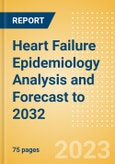Left ventricular ejection fraction (LVEF) is the central measure of left ventricular systolic function, calculated as the fraction of chamber volume ejected in systole in relation to the volume of the blood in the ventricle at the end of diastole. Based on limitations of physical activity, the New York Heart Association (NYHA) functional classification is the mostly used classification system which places HF patients in four classes (I-IV). Additionally, the American College of Cardiology Foundation (ACCF)/American Heart Association (AHA) staging system has defined HF into four stages i.e., A, B, C, and D (American Heart Association, 2023b). Although patients are diagnosed with HF based on NYHA class, however ACCF/AHA staging shows the progression of the disease.
Scope
- This report provides an overview of the risk factors, comorbidities, and the global and historical epidemiological trends for HF in the seven major markets (7MM: US, France, Germany, Italy, Spain, UK, and Japan).
- The report includes a 10-year epidemiology forecast for the diagnosed incident cases and diagnosed prevalent cases of HF. The diagnosed incident cases and the diagnosed prevalent cases of HF are segmented by age (0-18 years, 19-44 years, 45-49 years, 50-59 years, 60-69 years, 70-79 years, and 80 years and above) and sex. The report also includes the diagnosed incident cases and diagnosed prevalent cases of HF by ejection fraction (HF-PEF = LVEF =50%; HF-mrEF = LVEF = 40-49%; HF-REF = LVEF < 40%). Diagnosed incident cases of HF are further segmented based on acute HF hospitalizations, acute HF hospitalizations based on presentation, hospital length of stay, and re-admissions within 30 days post-discharge.
- Additionally, diagnosed prevalent cases of HF are segmented based on NYHA classes (class I-IV), diagnosed prevalent cases of HF-PEF, HF-mrEF, and HF-REF segmented based on NYHA classes, and diagnosed prevalent cases of HF by ACCF/AHA stages (stage B, C, and D). Although not covered in this report, the diagnosed prevalent cases of HF segmented by comorbidities such as coronary artery disease, hypertension, previous myocardial infarction, renal dysfunction or failure, anemia, diabetes mellitus, and atrial fibrillation can be found in the model.
- This epidemiology forecast for HF is supported by data obtained from peer-reviewed articles and population-based studies. The forecast methodology was kept consistent across the 7MM to allow for a meaningful comparison of the forecast diagnosed incident cases and diagnosed prevalent cases of HF across these markets.
Reasons to Buy
The heart failure epidemiology series will allow you to:
Develop business strategies by understanding the trends shaping and driving the global heart failure market.Quantify patient populations in the global heart failure market to improve product design, pricing, and launch plans.
Organize sales and marketing efforts by identifying the age groups that present the best opportunities for heart failure therapeutics in each of the markets covered.
Table of Contents
- About the Publisher








